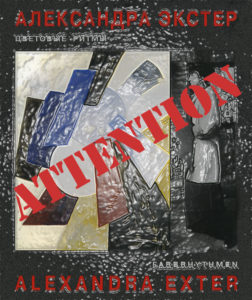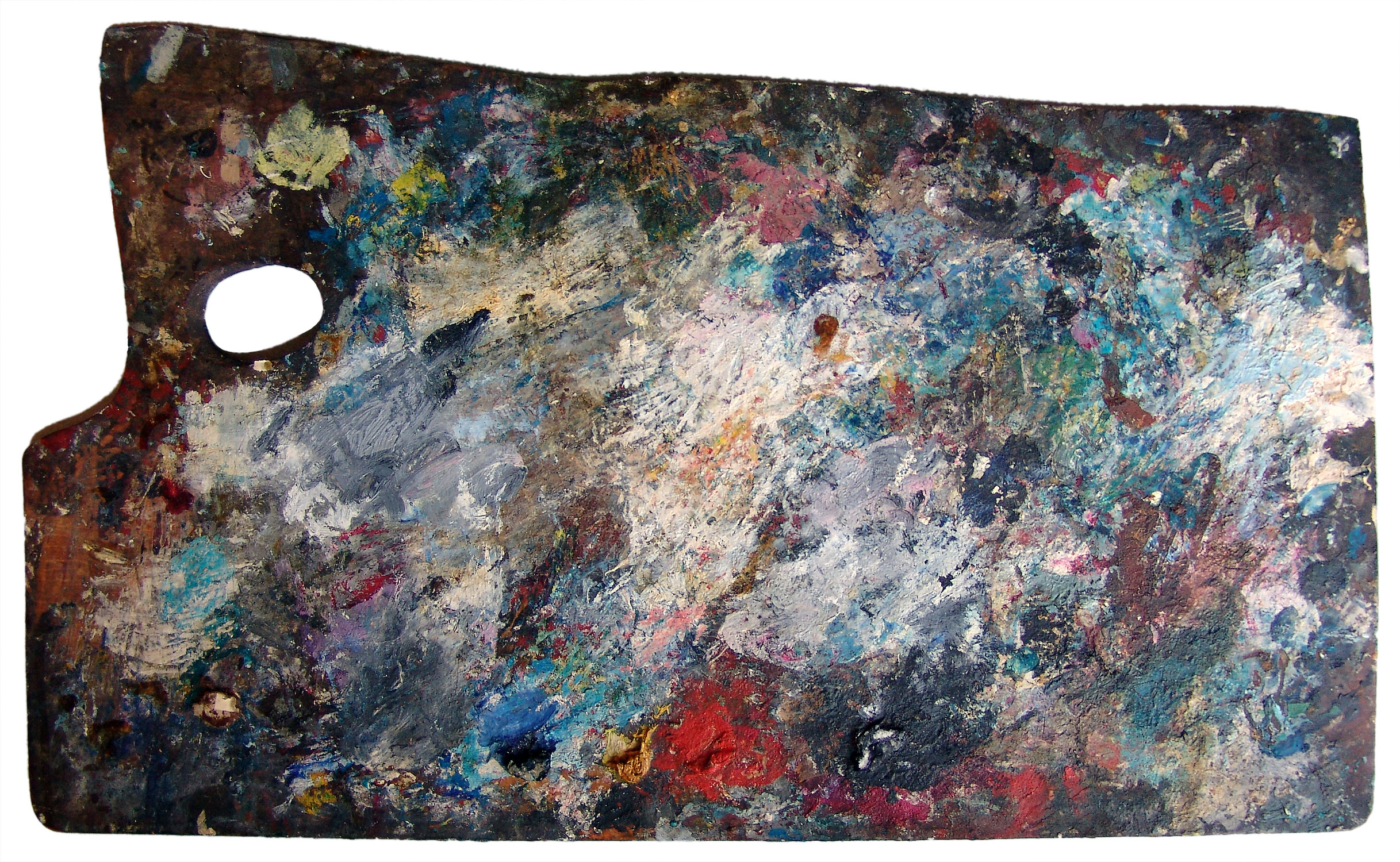The origins – and thence the proof of authenticity – of the “new works” circulating since the publication of Chauvelin and Filatoff’s Alexandra Exter (Paris, 2003) and even more so since the 2009 Château de Tours exhibition and catalogue raise the question of the provenance of the works. The fanciful provenance that makes reference to the “artist’s studio” often found in French auction catalogues between 2000 and 2005 has been gradually dropped in favor of a more fictionalized version. The introduction by Jean Chauvelin to the Tours exhibition catalogue (p. 10-11) was first published in May 2008 in a catalogue of the Pierre Berger auction house in Brussels
Here we would like to draw attention to another type of fabrication, destined to launder the “new” works.
At the end of the nineteen eighties a good number of apocryphal works appeared on the art market that were attributed to several Russian avant-garde artists and given a fictive provenance. There were then few studies dedicated to the history of the Russian avant-garde and especially few truly documented studies, which made this type of provenance credible to neophytes to the field of the Russian avant-garde – the category of buyers that was emerging at the time. Several works attributed to Alexandra Exter began circulating based on this supposed German provenance (Berlin).
There was even a highly publicized public sale at Christie’s in London, complete with a separate catalogue, on 5 October 1989.
Having made the necessary verifications, Andrei Nakov protested in writing to the auction house, which took no action. Because there was a market “demand” for the works, they preferred to ignore any discordant voices.
At issue is a great quantity of Russian avant-garde works, supposedly from the “collection of” Kurt Benedikt. Benedikt was an antique dealer, active in Berlin in the early nineteen- twenties, who specialized in historical artworks, particularly from seventeenth-century Holland (mainly furniture and decorative art). An enterprising dealer, Benedikt went to Russia at the beginning of the nineteen twenties to purchase the decorative objects that the new Soviet state was selling left, right and centre. Benedikt also worked for the Van Diemen gallery in Berlin and it was probably because of these personal contacts with the Soviet authorities that the gallery was chosen by the Commissariat of Enlightment (Education) for the “First Russian Exhibition” (after the new Soviet power was established). The rooms in the Van Diemen gallery were rented and the whole enterprise was entirely organised in Moscow. Even the publicity around the event was initiated in Moscow by sending Lissitzky as an envoy to Berlin. Together with Ilya Ehrenburg, a Russian correspondent working in Berlin, Lissitzky set out to promote new Russian art a few months prior to the opening of the show. Moscow also financed this propaganda enterprise (which included the launching of the periodical Gegenstand/Objet, the first issue of which was published at this time i.e. Spring of 1922).
Because of his commercial role, Kurt Benedikt figures on one of the photos documenting the opening of this deservedly famous exhibition in October 1922. Yet his role was purely commercial if not administrative, and hence it was restricted to his connection with the Van Diemen gallery, which merely served as a venue for the exhibition, with responsibility for handling the works brought there for the show.
As Andrei Nakov learned after much laborious research in German and Russian archives, Benedikt had no particular connection with Russian avant-garde art circles. Neither his name nor his address figures in archives where they would be expected to show up: the Bauhaus, Moholy-Nagy, Paul Klee, Adolf Behne (critic who was in touch with the Russians, and for good reason, since he was writing about them), Herwarth Walden, Flechtheim and others. Neither does he figure in Alexandra Exter’s address books even though she was in Berlin in October 1927 for her individual show at the “Der Sturm” gallery. On the occasion of an event that had a certain echo, one would have expected her to get back in touch with eventual collectors.
From this time (1989-1991) Andrei Nakov began carefully researching this imaginary provenance because he was intrigued by a Cubist-type work, a painting titled “Les Ponts de Paris”
Later, Andrei Nakov was personnaly contacted in Paris by the Munich dealers pivotal to the commercial circulation of the works of “Kurt Benedikt” provenance. He was obliged to soon realize from the number of works and especially their nature that we were dealing with a hoax. He had even the occasion to see a photographic “documentation”, “recomposed”, that is to say, manipulated. The period of digital manipulation of images had already begun…
It is regrettable that the donation of a painting with this provenance, attributed to Exter, was accepted by the Berlinische Galerie, Berlin’s modern art museum, and that it figured for many years (and maybe still does) on the walls of this institution and in its publications. Another abstract painting made its way into an important private Swiss collection, to be displayed recently in museums in London and Zurich and reproduced.
The “Kurt Benedikt” provenance has done so well over the past twenty years that a Russian art historian has published several works in reference to this “collection”
These developments rely on the publication of a single book
In addition, this author regularly authenticates works circulated by the Orlando gallery in Zurich, works that have recently proved to be connected to the group presented at the 2009 Tours exhibition, to which the last publication of this gallery explicitly refers (see elsewhere the detailed references to the paintings featured at the Orlando gallery).
The “catalogue raisonné” ploy
On several occasions in recent years, a “catalogues raisonné” of Exter’s work has been announced. At least two (separate?) enterprises of the sort have been announced, one in Paris (Chauvelin and Filatoff) and one in Russia (Kovalenko).
None of the authors associated with these repeated announcements has museum experience or training, and none has yet consulted or expressed the desire to consult the painter’s archives or those of Simon Lissim, his heir. Consequently, it is hard to imagine that these announcements have any basis in reality. In fact they incite us to be particularly on our guard.

Scientific experts
“Scientific analyses”, mainly of pigments and the support, have become the latest fashion in the field of authenticating and attributing paintings.
Lacking verified documented references and credible material studies of the painter’s practice, classified from an historical and stylistic point of view, everything is done to reassure the market with a pseudo-science that claims to be “exact”. There are laboratories in London, Paris and Cologne that specialise in the field. The conclusions are always the same: “there are no indications that would contradict the attribution of such and such a work” to a “work of that period”, and so ipso facto the work in question would be authentic.
In the absence of any standard of reference, of a data bank composed of works whose authenticity is perfectly documented, and consequently indisputable, such “expertise” cannot be taken seriously.
Alexandra Exter’s palette
In response to this type of fallacious argument, I submitted Exter’s palette to the specialist Dr. Marie Kokkori, author of a thesis at the University of London – Courtauld Institute of Art on the technical study of Russian avant-garde works from the Costakis collection in State Museum of Contemporary Arts in Thessaloniki, Greece.
Considering her area of expertise, in my opinion Dr. Kokkori is well qualified for this work. The results of her detailed 2006-2007 study of Exter’s palette now serve as a reference for the output of the artist in the last period of her life. The palette as a repertoire of colours – as an image – will surely serve art historians who know how to examine the works and compare the spectrum of colour relationship – an exercise that a qualified professional knows how to do and from which he/she can draw conclusions.
The same is true of the process of x-raying the paintings which is being undertaken and which, once again, will constitute a reliable reference. Let’s hope that the growing number of falsifications will serve to convince public institutions to apply this simple procedure systematically

